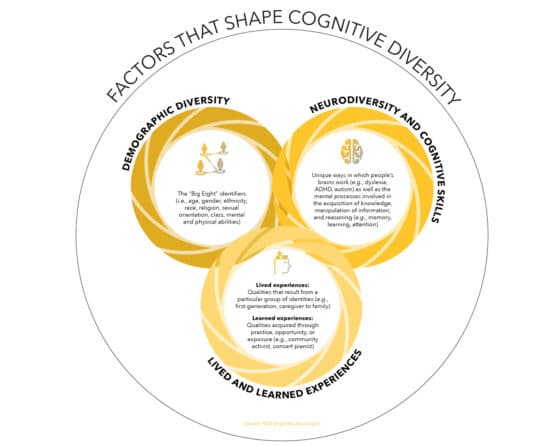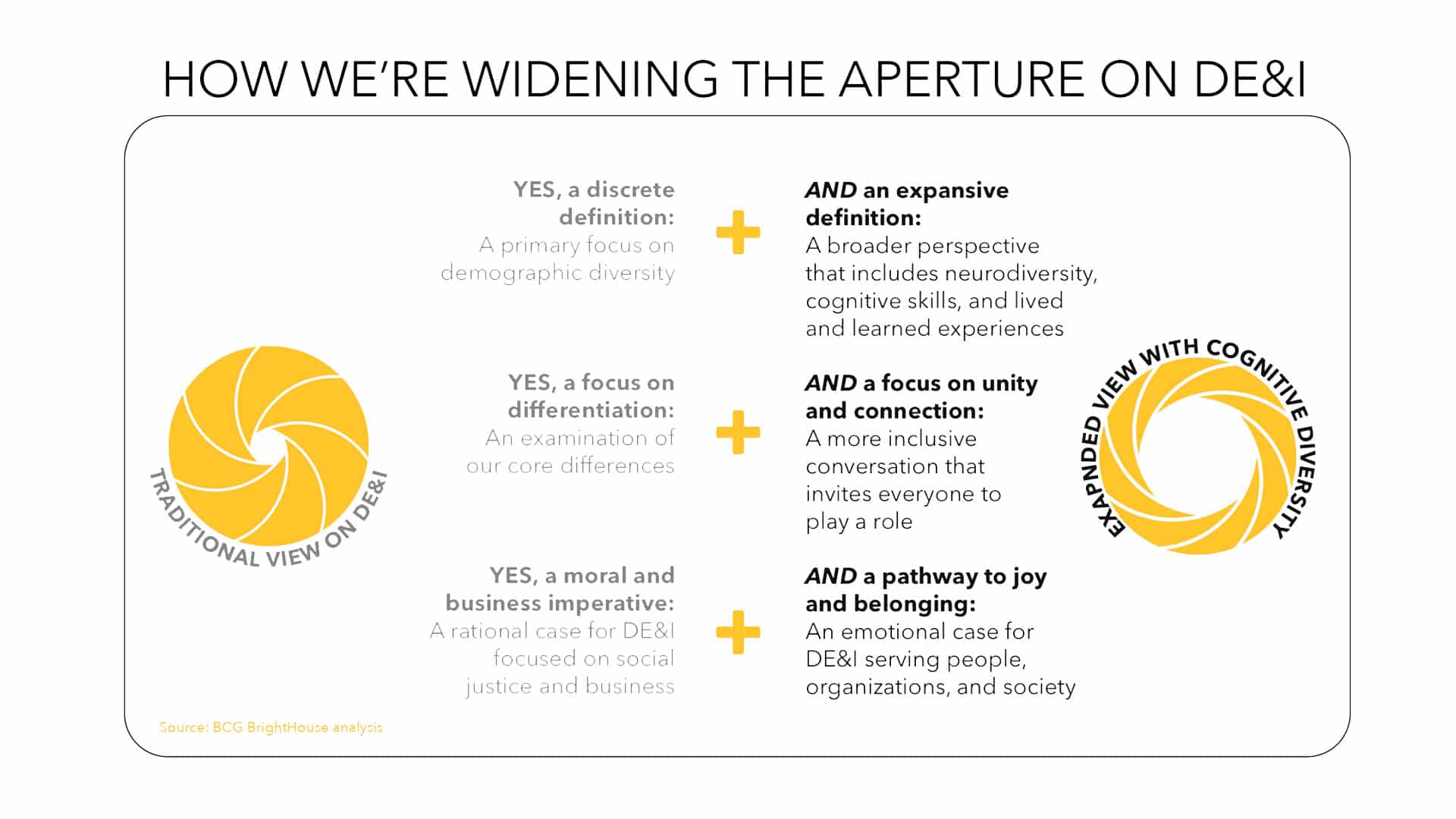Today’s Diversity, Equity, and Inclusion (DE&I) conversations tend to focus heavily on demographic fields of diversity – like gender, age, race, and ethnicity. While these are critical elements of our identity, they are often limited to a finite set of boxes that we can fit into. The downside of these conversations results in unconscious omission: when we narrow our view of DE&I, we crop out critical details from a larger, richer, and more complete picture. By extension, when we fail to see each person completely, as a whole, we don’t benefit from the fullness of their unique contribution and potential. And if this is true for an individual, it’s exponentially truer for a group. That’s why we’re seeking to widen the aperture on how diversity is understood by including Cognitive Diversity.
How Are We Viewing Cognitive Diversity?
When we use the term “Cognitive Diversity,” we are talking about something more than simply the physicality of our brains. We are recognizing the differences in the way we think – how we learn, understand, solve problems, imagine, and make meaning. We assess and observe Cognitive Diversity by comparing the individual in isolation and contrasting it with the group(s) that the individual belongs to. It can be shaped by a combination of these factors:

- Demographic Diversity
includes the “Big Eight” identifiers1 (i.e., age, gender, ethnicity, race, religion, sexual orientation, class, mental and physical abilities) - Neurodiversity and Cognitive Skills
include unique ways in which people’s brains work (e.g., dyslexia, ADHD, autism) as well as the mental processes2 involved in the acquisition of knowledge, manipulation of information, and reasoning (e.g., memory, learning, attention). - Lived and Learned Experiences
include qualities that result from a particular group of identities (e.g., first-generation, caregiver to family) or are acquired through practice, opportunity, or exposure (e.g., community activist, concert pianist).
Cognitive Diversity is a macro picture – a comparison of how these granular elements of the differences among us encourage us to exist, function, lead, and succeed in groups – and its context exists along a larger continuum. Ultimately, an environment that nurtures Cognitive Diversity will also demand cognitive equity and cognitive inclusion to reach the apex of belonging.
How is the Idea of Cognitive Diversity Shifting the Conversation Around DE&I?
Cognitive Diversity widens the aperture on how we approach DE&I. Let’s break down the paradigm shifts:
- YES, A Discrete Definition AND An Expansive Definition
Cognitive Diversity seeks to paint a larger picture of who people are at their core by expanding the aperture on diversity – including not only demographic diversity but also neurodiversity, cognitive skills, and lived and learned experiences. If we believe that the best ideas come from multiple minds while working towards a common purpose, then we must expand the definitions of diversity that dominate the landscape today. - YES, A Focus on Differentiation AND A Focus on Unity and Connection
Traditionally, DE&I strategies recognize diversity as a basis for identifying core differences. The unintended consequences of this practice could result in a sense of “othering” that may create a divide among different groups doing DE&I work. With Cognitive Diversity, we bring a unifying invitation for everyone to make a unique contribution as we work together and appreciate our differences, we strengthen our collective impact and allow the possibility for unexpected connections. - YES, A Moral and Business Imperative AND A Pathway to Joy and Belonging
With our work, we recognize the importance of bringing the moral and business cases together to create a more just, sustainable, and prosperous world. In addition, we bring another element – the emotional case for DE&I. We believe that when we form cognitively diverse teams and invite each member to bring their unique ways of thinking and being to the group, we experience a deeper sense of joy and belonging. With Cognitive Diversity, we see an opportunity to create an even more compelling case for DE&I for people, organizations, and society.

What’s Next?
In the next phase of our work, we will build on this definition and conduct research to understand why Cognitive Diversity matters – the impact it has on the workforce, business, and society. We will do this by looking at the role of Cognitive Diversity within teaming and by fielding a survey to capture perspectives of executive leaders around the world.
With a special thank you to the Cognitive Diversity team: Kes Sampanthar, Constance Braun, Nontalie Morrow, Anja Weigel, Chebon Ryan, Sarah Rosenberg, Katrina De Guzman
To print out this paper as a PDF Click Here
1 What is Diversity? Independent School Diversity Network. https://www.isdnetwork.org/what-is-diversity.html
2 Kiely, K.M. (2014). Cognitive Function. In: Michalos, A.C. (eds) Encyclopedia of Quality of Life and Well-Being Research. Springer, Dordrecht. https://doi.org/10.1007/978-94-007-0753-5_426